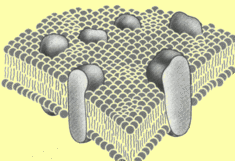Synthesis and Application of Membrane Proteins
Every cell behaves like an autonomous machine, with tools for sensing changes to the environment and to respond in ways that would ensure their survival. These critical functions are fulfilled admirably by proteins embedded in the cell surface membrane.
It comes as no surprise that they are involved with many diseases, especially if they fail to perform. It is crucial that we understand how they function and how to correct any abberant behaviour. Alternatively, they can harnessed to perform tasks never before observed in the natural world. An example is the transduction of light into electrical energy using the Light Harvesting Complex II protein from plants.
Our aim is to synthesise artificial membranes with such proteins embedded in them. This provides us with a source of pure membrane proteins and allows us to handle and manipulate them more easily. Join us as we explore the intriguing world of membrane proteins! Click on each protein to get a brief introduction to our work.


